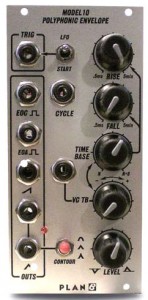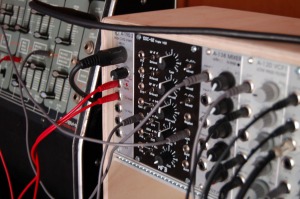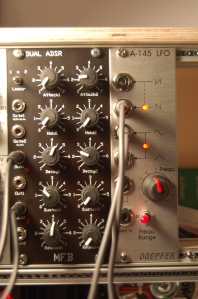
- Plan B Model 10
The PlanB model 10 is a multifunctional module, not only a simple envelope.
The name “polyphonic envelope” does not describe the functions of this great module, the reason why they called it “polyphonic” is because it can output 4 different type of voltage “envelope” at the same time.
In fact the M10 is way more versatile than an envelope, this is really similar to the Bananalogue VCS module, a multitask voltage controlled cv generator .
The main task is the ENVELOPE.
The envelope consist of an AD env with RISE (0.5 ms-5 min attack)and FALL (0.5 ms – 5 min decay/release) controlled not by gate signals but by Triggers.
The attack and decay time can stretched x8 times their duration with the TIMEBASE control knob (so the complete envelope can last from 0.5 milliseconds to 20 minutes).
You can stretch the time manually just turning the knob or controlling it with the VC TB (voltage control timebase).
The VC TB can act in positive or negative, so it can add or subtract.
Than there is the level of the env, which is bipolar too , so it can act as a positive or inverted envelope.
On the left there are the 5 connectors for the 4 different envelopes generated:
- EOC
- EOA
- RAMP
- 2x AD (with ad contour switch)
The AD acts as the classic “trig” envelope, with 3 different contour (log, lin, exp).
The RAMP is a ramp with rise time 2x the RISE control time.
The EOA is a sustained square which falls when receive a trig and performs the AD cycle at the “End Of Attack”.
The EOC acts as the EOA but the AD starts at the End Of Contour.
LFO MODE
The rise-fall cycle can be looped and can also work as an lfo.
Using the rise and fall it can produce various waveform between the tri, square, saw, ramp…
The interesting thing is that the timebase knob can control the time of the lfo, so it a vc lfo, the other thing that can lead to creative results is the fact that the rate of the lfo is not controlled by the timebase only, but it ‘s a mix of the rise and fall time.
So the shorter is the R&F the faster will be the lfo rate.
VCO MODE
The third interesting mode is the vco function.
The module has a triangle-core , so it can sound useful even as a vco.
To get the vco mode you have to switch into LFO and use fast R&F time and “tune” the oscillator with the timebase function and VC TB to control it with a keyboard cv.
It does not reach very high frequencies but can be used on the low and mid range as an audio modulator or a audio source.
TIPS:
I noticed two useful tips:
- As the core is a TRI-core the envelope create a sort of clip when, reached the max value,start the fall.
To avoid the clip it’s useful to use a lowpass filter post the VCA. - In LFO mode don’t connect any source to the trig in because the summing of the two sources can damage the module , too high voltage!





